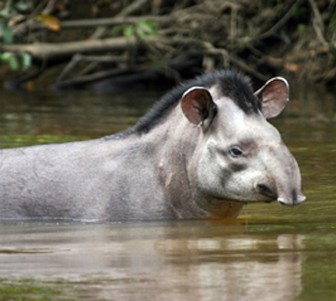The Brazilian Lowland Tapir (Tapirus terrestris) lives only in South America. In Guyana, the tapir is also known as ‘Bush Cow‘ (the animal, not the vehicle). Tapir are a uniform brownish grey and one of the largest mammals found in the Rain Forest, weighing in at as much as 250 kg! The tapir has a short stiff mane of dark hair which runs from forehead to shoulder, a short stumpy tail, four toes on its front legs and three webbed toes on its hind feet. With its elongated nose, this large, strange animal looks like a cross between an elephant, a hippopotamus and a cow, but its closest relatives are actually horses and rhinoceroses. Young tapir are mini versions of their parents but have bright yellow or white spotty stripes running along their sides and legs.
![]() Their webbed feet make them adept swimmers and they can be seen on river edges, swamps or walking along lush river bottoms in the Iwokrama Rain Forest or forested areas in the Rupununi. They are all-terrain animals who are at home in any dense vegetation and forest. This shy vegetarian has an excellent sense of smell and uses its prehensile nose to sweep leaves, grass, shoots and fruits into its mouth.
Their webbed feet make them adept swimmers and they can be seen on river edges, swamps or walking along lush river bottoms in the Iwokrama Rain Forest or forested areas in the Rupununi. They are all-terrain animals who are at home in any dense vegetation and forest. This shy vegetarian has an excellent sense of smell and uses its prehensile nose to sweep leaves, grass, shoots and fruits into its mouth.

Tapirs are the largest forest mammal in Guyana and are usually silent, but snort and stamp in alarm. When they want to communicate, they do so with a loud, piercing whistle, and as they answer imitations of this call, hunters can easily find and shoot them for meat. As a result they are easy targets for hunters and this pressure along with habitat destruction has made them vulnerable to local extinction. Makushi people believe that new mothers should not eat tapir meat as the spirit of the animal would stamp on the spirit of the child and affect the development of the baby.
Rain forests are rich in biodiversity and are home to many different plants and animals as well as indigenous communities. Humans, even those who don’t live in the rain forest, rely on it for resources such as building materials (wood and lianas), medicine and fruits. Rain forests also provide essential environmental services for life on earth; they create soil as well as prevent soil erosion, produce oxygen though photosynthesis, maintain clean water systems, and are a key defence against climate change.
The Iwokrama Rain Forest is 371,000 hectares, located in the heart of Guyana. Our mission is to develop strategies for conservation and sustainable development for local people in Guyana and the world at large. We are involved in timber, tourism and training. Come and visit us in the rain forest or at http://www.iwokrama.org.









